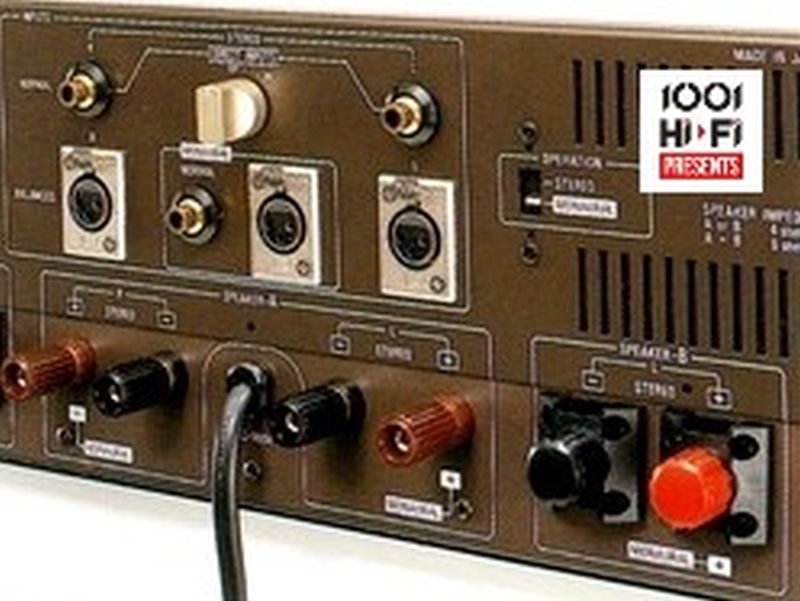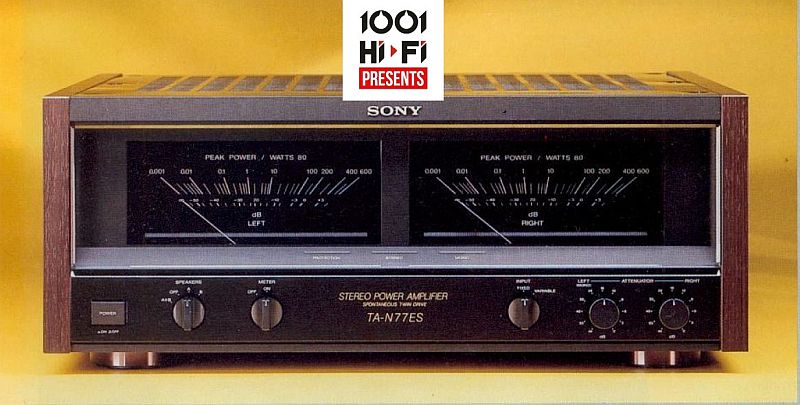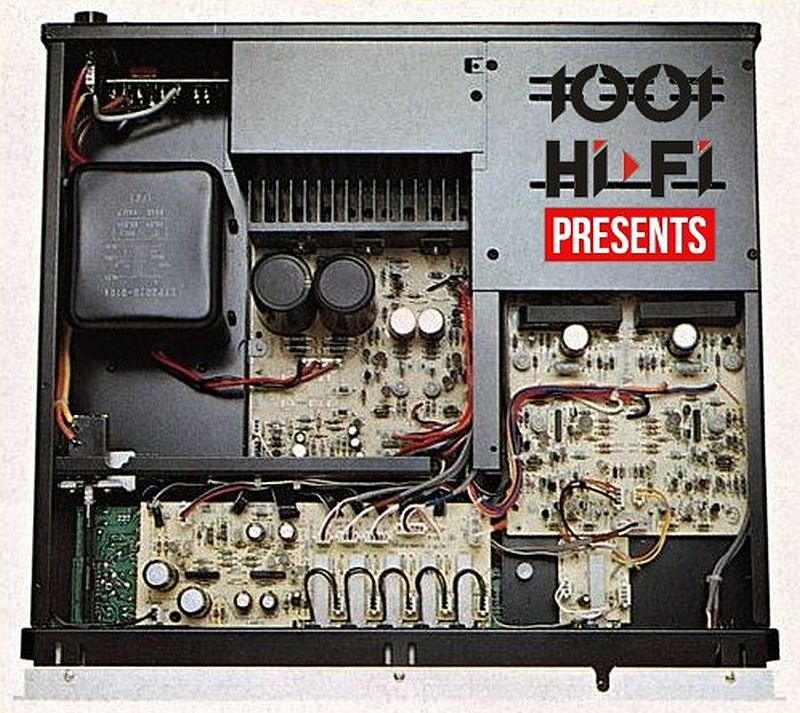DENON POA-3000RG / PRA-2000RG (JAPAN 1991)
The first model of the PRA-2000 / POA-3000 series from DENON was introduced in may 1979. Production has continued for 14 years and the 4th generation, the PRA-2000RG / POA-3000RG, were manufactured until 1993. This power amplifier used a DENON proprietary technology called "MOS Super Optical Class A Circuit" This new inverted-Darlington connection in the driver stage allows a flow of bias current 10 times higher than the previous DENON Optical Class A circuit. Supporting this optical power amplifier is "optical coupling" which transmits the control signal from the bias control circuit to the bias circuit. By using the optical element, the interference between the main signal system and the bias control circuit is completely eliminated, and the bias control is realized at high speed. The amplifier delivers 250 W/ch in Stereo mode while the power increases to 500W when switched to mono operation. For the power section a large toroidal transformer is used with large power source capacitors. Current is independently supplied to the power stage and the pre-driver stage, all this through a complete dual mono construction. Rated output STEREO: 250 W + 250 W (8 Ohm, THD: 0.05%), 400 W + 400 W (4 Ohm, THD: 0.1%) | MONAURAL: 500 W (8 Ohm, THD: 0.05%), 800 W (4 Ohm, THD: 0.1%) | Total harmonic distortion rate: STEREO: 0.005% (20 Hz to 20 kHz, 8 Ohm, -3 dB) | Intermodulation distortion: 0.003% or less (7 kHz / 60 Hz = 1/4, 8 ohms) | Output bandwidth: STEREO / MONO: 5 Hz to 50 kHz (THD: 0.05%, 8 Ohm, -3 dB)
Frequency characteristic: STEREO / MONO: 1 Hz to 100 kHz (8 ohm, 1 W output) | Dimensions: 495 (W) x 200 (H) x 490 (D) mm (including knobs, leg height) | Weight: 35.5 kg
Frequency characteristic: STEREO / MONO: 1 Hz to 100 kHz (8 ohm, 1 W output) | Dimensions: 495 (W) x 200 (H) x 490 (D) mm (including knobs, leg height) | Weight: 35.5 kg
EXCLUSIVE BY PIONEER M3 / C3 (JAPAN 1973)
The "soul of audio" combined with the advanced art of high-fidelity electronics is behind the unique concept of the EXCLUSIVE M3 stereo power amplifier by Pioneer. Analyses of both the "dynamic" and the "pulsive" characteristics of audio were studied carefully in the creation of the M3. These include transient response, crossover distortion and many other critical aspects of performance. Such static characteristics as power bandwidth and frequency response were also closely examined. The results are as brilliant as they are daring. To illustrate, consider the problem of providing stability versus the question of assuring wide frequency response and minimum distortion. Pioneer designed an entirely new type of circuit for the M3 to achieve both: it features the reliable circuit design and high-quality parts for stability, yet allows a small amount of negative feedback to be applied to improve frequency response and assure low-distortion performance. Sophisticated features like peak-power level meters, a front sub-panel providing access to speaker selector and function of the M3. Individual technical-data sheets giving the exact test information for each unit is packed with every M3 as it leaves the Pioneer factory. The EXLUSIVE M3 is the perfect blend of technology and musicality, the stereo amplifier you can depend on to deliver the "soul of audio" without compromise. As a quality power amplifier for musical reproduction, the M3 has no peer. It offers you RMS 150 watts+150 watts of continuous power (both channels driven at 8 ohms) within critical 20-20,000 Hz frequency range, with both harmonic and intermodulation distortion held to less than 0.1%. There are two large, very precise peak power level meters on the front panel of the M3. The peak transient levels as high as 20dB contained in any audio signal are indicated instantly and accurately. Compared with ordinary VU meters, the power indication range of this peak meter is exceedingly wide: 0.01W to 200W on a logarithmic compression scale, operating from built-in circuits, thus, you can read the power level without changing meter sensitivity.
SONY TA-N77ES / TA-E77ESD (JAPAN 1988)
Introduced in 1988 the SONY TA-N77ES was the only power amplifier ever from SONY to support large VU meters as a visual element.
Power amplifiers are usually tested when hooked up to 8-ohm laboratory resistors. While results may look fine on a spec sheet, they simply ignore an undeniable fact. Real loudspeakers - even those nominally rated at 8 ohms - simply refuse to behave like laboratory resistors. While the resistor presents a simple impedance that's constant at all audio frequencies, the speaker presents a complex impedance that varies dramatically. A typical "8-ohm" loudspeaker can have impedance peaks higher than 30 ohms and impedance dips lower than 3 ohms! And here's the catch: as impedance drops, more and more current is demanded from the amplifier. Thanks to large power transformers, generous power supplies, big output transistors and massive heat sinks, the SONY TA-N77ES produce this current in casual disregard of loads. In preference to inexpensive integrated circuit "power packs" SONY ES insists on individual (discrete) output transistors. Sony's carefully-selected discrete transistors cost more, but their enhanced cooling, proven reliability and superior frequency response make them more than worth the cost. To reduce resonance and vibration Sony used a G-Base made of calcium carbonate reinforced with glass fibers, a unique compound similar in composition to marble. To accompany the SONY TA-N77ES power amplifier there were two remote controlled preamplifiers, the SONY TA-E77ES and the TA-E77ESD with added Digital inputs. Technical data: 200 W/ch 20-20,000 Hz 8 ohm THD 0.004% Dimensions: 470 W x 185 H x 440 D mm, Weight: 25 kg.
Power amplifiers are usually tested when hooked up to 8-ohm laboratory resistors. While results may look fine on a spec sheet, they simply ignore an undeniable fact. Real loudspeakers - even those nominally rated at 8 ohms - simply refuse to behave like laboratory resistors. While the resistor presents a simple impedance that's constant at all audio frequencies, the speaker presents a complex impedance that varies dramatically. A typical "8-ohm" loudspeaker can have impedance peaks higher than 30 ohms and impedance dips lower than 3 ohms! And here's the catch: as impedance drops, more and more current is demanded from the amplifier. Thanks to large power transformers, generous power supplies, big output transistors and massive heat sinks, the SONY TA-N77ES produce this current in casual disregard of loads. In preference to inexpensive integrated circuit "power packs" SONY ES insists on individual (discrete) output transistors. Sony's carefully-selected discrete transistors cost more, but their enhanced cooling, proven reliability and superior frequency response make them more than worth the cost. To reduce resonance and vibration Sony used a G-Base made of calcium carbonate reinforced with glass fibers, a unique compound similar in composition to marble. To accompany the SONY TA-N77ES power amplifier there were two remote controlled preamplifiers, the SONY TA-E77ES and the TA-E77ESD with added Digital inputs. Technical data: 200 W/ch 20-20,000 Hz 8 ohm THD 0.004% Dimensions: 470 W x 185 H x 440 D mm, Weight: 25 kg.
TECHNICS SU-C3000 / SE-A3000 (JAPAN 1998)
The Technics SU-C3000 pre-amplifier and SE-A3000 power amplifier were introduced in 1999. The preamplifier uses a so called "Variable Gain Control" volume control for minimum noise and 124 dB signal to noise ratio while the unit is battery operated. The preamplifier features two Pre-Output for two power amplifiers. The power amplifier uses a dual-mono construction and can be used in Bi-Amp mode. Technical data: 100 W/ch RMS, 8 ohm, 20-20,000 Hz. THD 0.01% Dimensions: 453x186x441 mm (SE-A3000)
VICTOR (JVC) M-L10 / P-L10 (JAPAN 1981)
The Victor (JVC) M-L10 power amplifier was introduced in 1981 and was based on the earlier Laboratory Series M-7050 from 1979. The power amplifier is based on the high efficiency class A operation method called "Super A" with zero switching noise. The output stage transistors operate at a constant voltage, only the current is changed, and the whole stage adopts a cascade circuit construction. A distinctive (21 step lacquering) mirror finish real wood cabinet is used for both the pre-amplifier and power amplifier. This beautiful Laboratory Series amplifier combo was sold under the Victor brand name in Japan while worldwide it was sold as JVC. Technical data: 160 W/ch (RMS, 8 Ohm, 20Hz-20Khz, 0.002%THD), Dimensions: 46*20.35*41.75, Weight: 28 kg
















































